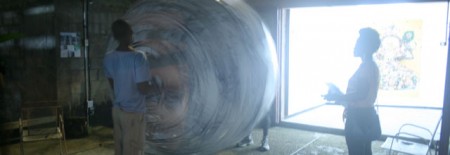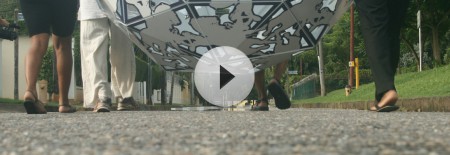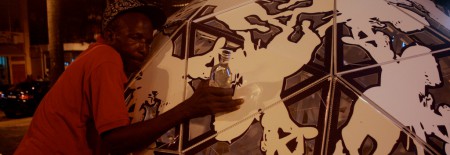CHARLES CAMPBELL AND NICOLE SMYTH-JOHNSON
On Monday April 21, 2014 Charles Campbell unveiled Actor Boy: Fractal Engagement, a commission of the EN MAS’: Carnival and Performance Art of the Caribbean Project. Campbell recruited the support of project assistant Deborah Anzinger and community leader Kemar Black (both artists in their own right) to develop a concept for a community parade that would complicate the boundary between spectator and participant. He invited two dozen arts practitioners and enthusiasts from Jamaica’s proverbial “uptown”—a geographic and social category denoting Kingston’s middle and upper classes—to participate in a procession “downtown”—those parts of the city “south of Crossroads,” plagued by poverty, garrison politics, and gang violence.
Campbell had just returned to Jamaica to take up a post as Chief Curator of the National Gallery of Jamaica, itself located downtown on Kingston’s once luxurious waterfront. After years of exhibiting in Jamaica and the region while living in Canada, he was now taking his engagement to a new level with a key role at the oldest and largest public art museum in the English-speaking Caribbean.
The following is an excerpt from an interview with Campbell; the curators of En Mas’, independent curator Claire Tancons and art historian Krista Thompson; Kemar Black, an artist from the Matthew’s Lane community; and Natasha Levy, one of the invited participants in the procession. The interview took place on May 1, 2014, and was organized by New Local Space (NLS) as part of IN, a series of monthly online art discussions, which are broadcast via Google Hangouts and archived on NLS’ YouTube page.
NICOLE SMYTHE-JOHNSON: Tell me about Fractal Engagement. What were some of your preoccupations in developing this project?
CHARLES CAMPBELL: This project developed while I was researching another project for the National Gallery on muralists and street artists from downtown Kingston. I was going into a lot of inner city communities, and one thing maybe not all of the audience will know is that Kingston is a very divided city in terms of uptown and downtown. A lot of people move back and forth between those borders but still there are some pretty defined boundaries.
So I was really interested in how the artists involved in the project transgressed the boundaries within their communities. Even within uptown and downtown there are gang and political boundaries and so on, and it was really interesting for me how the artists kind of had a pass to move across these.
That was the kernel that inspired the project, and I started thinking a lot about the uptown-downtown boundary and developed the project around ideas of changing the relationship between those two communities….





